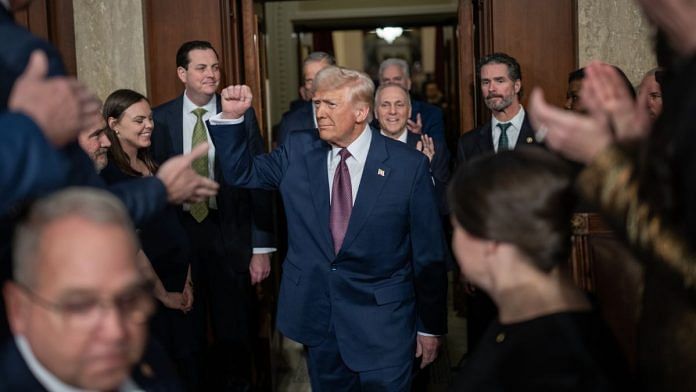New Delhi: US President Donald Trump has shifted his tariff focus on India from motorcycles to automobiles. In his speech to Congress Tuesday, he said that India was charging the US “higher than 100 percent” tariffs on automobiles. This marks a change from his first term, when he complained that India’s tariffs on motorcycles were “unacceptable”.
The reason for this change is that India has systematically cut the import duties on luxury motorcycles, with the latest cut being in the Union Budget 2025-26, announced on 1 February.
The tariffs on automobiles remain higher than 100 percent, while the scheme designed to provide lower tariffs for electric vehicles is still awaiting operational guidelines, despite having been notified a year ago.
“On average, the European Union, China, Brazil, India, Mexico and Canada… and countless other nations charge us tremendously higher tariffs than we charge them,” Trump said during his address to the US Congress Tuesday evening (Washington time). “It’s very unfair. India charges us auto tariffs higher than 100 percent.”
Tweaked auto tariffs, but effective rate unchanged
In the Budget presented by Finance Minister Nirmala Sitharaman, the changes to the import duty structure on automobiles was categorised under the heading ‘Decrease in tariff rate with no change in effective rate’.
Earlier, the government levied a 100 percent basic customs duty on motor vehicles principally designed for the transport of persons priced above $40,000. Over and above this, it levied a 10 percent Social Welfare Surcharge (SWS) of 10 percent, taking the effective tax rate to 110 percent.
From 1 April onward, the basic customs duty will reduce to 70 percent, but an Agriculture Infrastructure Development Cess of 40 percent will replace the SWS. This means that the effective tax rate will remain 110 percent.
Trump told Congress that reciprocal tariffs on a number of countries, including India, will take effect from 2 April. This came hours after 25 percent tariffs against US’s biggest trade partners, Mexico and Canada, and a 10 percent levy on Chinese imports kicked in.
“If you don’t make your product in America, under the Trump administration you will pay a tariff and, in some cases, a rather large one,” Trump further said. “Other countries have used tariffs against us for decades and now it’s our turn to start using them against those other countries.”
EV concessions fail to get off the ground
While the Centre announced several customs duty cuts on components that go into EV batteries, it is yet to operationalise its subsidised customs duty scheme for EVs.
In March last year, the government notified a policy under which EV manufacturers who make a minimum investment of $500 million in India and source a certain amount of their inputs from here, would receive a concessional import tariff of 15 percent (down from 100 percent) on EVs priced above $35,000.
However, guidelines of the policy have not yet been finalised, and the government has so far found no international takers, including Elon Musk’s Tesla.
Trump triumphs on motorcycle issue
On the other hand, Trump has met significant success when it comes to India’s import duties on motorcycles. During his first term, he brought up India’s 100 percent tariffs on luxury motorcycles a number of times, including during meetings with Prime Minister Narendra Modi.
In February 2018, India halved the import tariffs on such bikes to 50 percent. However, this too was not enough for Trump. In 2019, he again talked about how a 50 percent tariff on luxury motorcycles was “still unacceptable”.
That rhetoric has now changed, possibly because, in the latest Budget, the government further reduced tariffs on motorcycles with engine capacity of 1600 cc and above—basically the luxury bikes—to 30 percent.
(Edited by Sanya Mathur)
Also Read: Why Trump’s bid to end China’s rare earth mineral monopoly may trigger a geopolitical headache







The Modi government has been way more protectionist in it’s approach towards international trade. It’s intense focus on “protecting” Indian industry from competition has only benefited a handful of Indian MNCs. This has also given rise to crony capitalism. Also, the absurdly low corporate tax over the last decade was intended to increase private investment in the country but all it has achieved is that Indian MNCs are increasingly investing overseas rather than in India. Private investment in India from Indian industry has been abysmal.
So, tax benefits extended by the Indian government are ending up creating physical infrastructure and jobs in foreign countries.
The need of the hour is to dismantle this protectionist regime. It has most certainly not benefited Indians.
If Trump and his theatre of the absurd act as catalyst for this change – it would be most welcome.
Modi government thinks it understands economics and finance. The reality is, it does not. The pathetic investment levels in India, both from Indian industry/MNCs as well as FDI, clearly shows that. The only thing such idiotic protectionism has helped is to create the perfect conditions for crony capitalism to flourish.